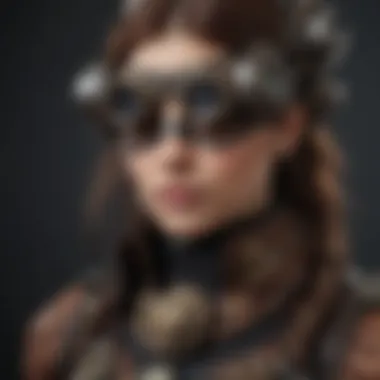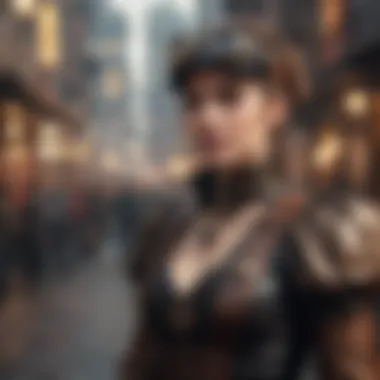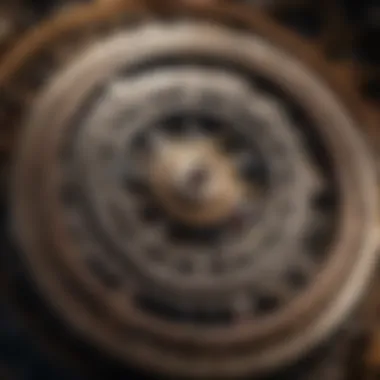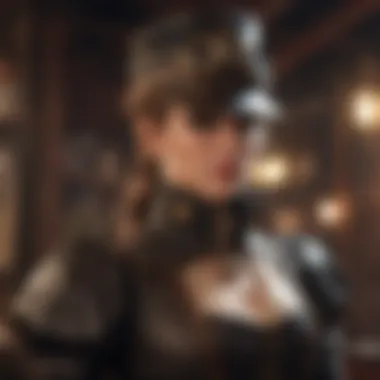Exploring the Intriguing World of Steampunk Cosplay


Intro
Steampunk cosplay is a multifaceted domain that integrates history, imagination, and craftsmanship. Rooted in Victorian-inspired aesthetics, it invites individuals to express themselves creatively through intricate costumes, accessories, and character portrayals. This subculture not only thrives within the realms of conventions and fairs but also extends to communities online. Here, we explore the prominent aspects of this fascinating world, including its historical foundations, community dynamics, and distinctive features that set it apart from other cosplay genres.
Overview of Cinema/TV shows/Games/Comic Books
Cinematic Inspirations
Steampunk has secured a considerable presence in film and television. Titles such as The Prestige and Wild Wild West incorporate elements that resonate with steampunk's unique style. These works visually represent an alternate reality where steam-powered machinery dominates. The aesthetics in these films often encourage fans to reinterpret their favorite characters in fresh, steampunk-infused ways.
Gaming Influence
Notably, steampunk aesthetics have permeated the gaming world as well. Games such as Bioshock Infinite and Dishonored feature intricate worlds imbued with the steampunk ethos, drawing players into narratives that meld history with speculative fiction. These video games not only showcase stunning art but also encourage fans to create their own interpretations through cosplay.
Comic Book References
Various comic books have embraced steampunk. Series like Lady Mechanika present narratives enriched with ornate artwork and compelling stories. Fans find inspiration in these graphic novels, leading to the emergence of distinct character interpretations within the cosplay community.
Community Dynamics
The steampunk community is diverse, characterized by its passionate individuals united by a shared love for the aesthetic and culture. Conventions, online forums, and social media platforms play pivotal roles in connecting enthusiasts. Events often see participants showcase elaborate costumes, share techniques, and exchange tips on craftsmanship.
"Steampunk cosplay is the perfect blend of creativity and artistry, bringing history into the modern era."
An essential part of the community involves collaboration. Many cosplayers work together to develop complex costumes, often forming groups that enhance the overall experience at conventions or online platforms.
In-Depth Analysis
Character Development
Steampunk cosplays often draw from fictional characters as well as original creations. Each character comes with a backstory that is rich and filled with personality. The depth of character is essential for cosplayers to bring authenticity to their portrayals, allowing participants to immerse themselves in the world they embody.
Craftsmanship and Design Elements
Costume design plays a central role in steampunk cosplay. From meticulous detailing to the selection of materials, cosplayers focus on craftsmanship. Elements like brass gears, goggles, corsets, and leather add to the overall appearance. Each aspect, whether large or small, adds depth to the costume.
Finale
As the steampunk cosplay community grows, it reflects broader trends within fandom culture. It encourages creativity and invites a reinterpretation of history. By constantly evolving and embracing new forms of media, steampunk cosplay remains a vital part of contemporary culture, allowing individuals to explore their identities across various platforms. Its future lies in its ability to inspire and adapt, ensuring it continues to captivate audiences for years to come.
Preamble to Steampunk Cosplay
Steampunk cosplay stands at the crossroad of creativity and historical fascination. This genre allows individuals to express their unique take on an alternate reality—one where steam-powered machines and Victorian aesthetics converge. Its importance lies in the blend of history, fantasy, and the art of recreation. Cosplaying in this manner offers enthusiasts a chance to not just don a costume but to embody an entire narrative, thereby enriching the experience of both the wearer and the observers.
Understanding Steampunk as a Genre
Steampunk as a genre transcends simple aesthetics and moves into a fusion of technology and art. It draws heavily from the Victorian era, infusing elements of fantasy and science fiction. Works by authors like H.G. Wells and Jules Verne provide a foundation for this genre, promoting a vision of the past filled with imaginative technology.
Key characteristics of steampunk include:
- Anachronistic technology, appearing advanced for its time but still grounded in 19th-century science.
- A focus on craftsmanship and elaborate design in costumes and props.
- An emphasis on exploration, adventure, and the impact of technology on society.
The genre often serves as a platform for commentary on current technological trends, examining the delicate balance between progress and its implications. In essence, steampunk is a celebration of invention and human spirit, allowing for a creative exploration beyond the constraints of present-day life.


Cosplay Defined: Context and Purpose
Cosplay, short for costume play, involves participants dressing in themed attire to represent characters from various forms of media—books, films, games, and more. The context of cosplay within the steampunk community is particularly vital, as it marries the theatrical aspects of performance with a deep appreciation for the craftsmanship behind each costume.
The purpose of steampunk cosplay encompasses several layers:
- Expression of Individuality: Every cosplayer brings their own interpretation, resulting in a unique blend of style and character.
- Community Engagement: Events and conventions serve as gathering points for fans, fostering collaboration and friendship.
- Craft and Artistry: Many cosplayers take pride in the construction of their outfits, often showcasing advanced skills in sewing, crafting, and design.
In steampunk cosplay, one does not just wear a costume; they engage in a complete transformation, often assuming the identities and backstories of their characters. This engagement provides a deeper connection to the genre and an opportunity to appreciate its cultural significance.
Historical Context of Steampunk
Understanding the historical context of steampunk is vital to grasping its essence and appeal. Steampunk is not just a costume trend; it is a cultural movement that intertwines art, literature, and retro-futuristic technology. The genre's roots can be traced back to the 19th century, a period marked by rapid innovations in science and technology. It draws heavily from the aesthetics and inventions of this era, blending them with imagination. Within this framework, costume designers and cosplayers alike find endless inspiration for their creations.
19th Century Inspiration
The 19th century serves as the primary inspiration for steampunk. During this time, the Industrial Revolution transformed society, introducing steam-powered machines and advanced manufacturing processes.
- Gothic Architecture: Structures were grand and ornate, influencing the design of costumes and accessories.
- Victorian Fashion: Clothing styles included corsets, waistcoats, and cravats, which are now staples in steampunk attire.
- Technological Innovations: Inventions such as the steam engine, clockwork mechanisms, and early electronics capture the imagination and influence costume designs.
The marriage of mechanical elements with romanticism in the 19th century offers a rich tapestry for steampunk. Cosplayers often incorporate gears, cogs, and vintage elements to bring this aesthetic to life.
Literary Roots: Key Authors and Works
Steampunk draws not only from visual elements but also from literature. Several key authors have shaped its narrative landscape and ethics. Their works illustrate not just technology, but also social dynamics and philosophical questions inherent in a technologically advanced society.
- H.G. Wells: Known for The Time Machine, Wells explored themes of time travel and class disparity, providing a moral context that resonates in steampunk storytelling.
- Jules Verne: In books such as Twenty Thousand Leagues Under the Sea, Verne’s adventures merge fantasy with technological speculation, laying a foundation for many steampunk designs.
- Philip Pullman: In The His Dark Materials trilogy, elements of Victorian aesthetics and mechanical wonder evoke the spirit of the genre.
Literature not only imbues steampunk with depth, but it also captures the imagination of cosplayers, driving them to embody the stories these authors brought to life.
Understanding the historical roots reinforces the framework of steampunk cosplay. Knowing the influences behind costume design can provide an insight into the broader cultural significance of the movement. This perspective fosters a deeper appreciation of individual creations within the steampunk community.
Aesthetic Elements of Steampunk Cosplay
The aesthetic components of steampunk cosplay are fundamental to its appeal and differentiation within the broader cosplay community. This genre thrives on a careful blend of Victorian-era design, mechanical ingenuity, and imaginative reinterpretation of technology. Each element contributes to creating a visually immersive experience that resonates with both participants and observers.
Fashion Inspirations: Clothing Styles
Steampunk clothing draws heavily from 19th-century fashion, incorporating elements like corsets, waistcoats, and long coats. Layering is key; it often features multiple garment layers, combining textures and fabrics such as leather, lace, and wool. Patterns may include paisley or plaid, reflecting the complexity of the era's textiles.
Beyond just historical accuracy, many cosplayers express individuality through their outfits. For example, adding contemporary twists to traditional designs is a common practice. This could involve a modern cut or different fabric, allowing character interpretations without losing the steampunk essence.
When selecting a wardrobe, practical considerations also play a role. Fabrics must be comfortable for extended wear, especially during conventions. As such, steampunk fashion balances authenticity with wearability, enhancing the overall cosplay experience.
Accessories: The Importance of Detail
In steampunk cosplay, accessories are not merely add-ons; they are crucial to embodying the essence of a character. Items such as goggles, hats, and pocket watches are not only visually striking but also enrich the narrative of the cosplay. Each piece tells a story. For instance, a well-crafted pair of goggles suggests a character's adventurous spirit or occupation as an inventor.
Moreover, attention to detail can elevate a costume from ordinary to exceptional. Consider the craftsmanship behind a finely designed belt or the choice of a unique brooch. These accessories provide opportunities for personalization, where small details reflect the wearer’s creativity and inspiration.
Prop Making: Tools and Techniques
Prop making is another essential aspect of steampunk cosplay. The genre relies on an array of gadgets and tools that enhance character portrayal. The creation of props often involves repurposing common items. For example, an old flashlight can transform into a steampunk servo with paint and embellishments.
Understanding tools and techniques is critical in this process. Basic skills in woodcraft and metalworking can greatly aid in building intricate props. Resources available online, such as tutorials on Reddit or Facebook groups, offer invaluable insight and support from fellow fans.


Integrating electronics for lights or sound effects can also be part of prop making, representing the innovative spirit of steampunk. Overall, the creative process of prop creation allows cosplayers to deepen their engagement with the theme, crafting items that reflect both realism and fantasy.
Key Features of Steampunk Costumes
Steampunk cosplay stands apart from other variations of costume design due to its reliance on a specific aesthetic that fuses Victorian influences with elements of science fiction and fantasy. The key features of these costumes are crucial because they help express individual creativity while remaining authentic to the steampunk genre. Understanding these features allows cosplayers to effectively embody the spirit of steampunk while drawing inspiration from its rich historical context.
Materials Commonly Used
Materials play a significant role in steampunk cosplay. The choice of fabric and other components determines not only the overall look of the costume but also its functionality and comfort. Commonly used materials include:
- Cotton and Linen: Often used for its breathable nature, cotton can mimic the textiles of the Victorian era. Linen is lightweight and drapes well, thus forming elegant attire.
- Leather: This material is essential for creating accessories such as belts, gloves, and harnesses, adding a rugged charm that aligns with the steampunk imagery.
- Velvet and Brocade: Rich textures like velvet and brocade can signify wealth and nobility, crucial in depicting the class structures present in the Victorian period.
- Metal and Plastic: These components are often utilized for props and accessories. Metal may reflect gears or other engine-like features, whereas plastic can be molded into different shapes for a more lightweight design.
Understanding how these materials contribute to the overall aesthetic can inform better choices while crafting your costume.
Color Palettes and Textures
Color palettes and textures are significant in evoking the sentiments associated with steampunk. The visual style typically involves a particular range of colors and finishes that create a cohesive and immersive experience. Commonly seen hues include:
- Earth Tones: Colors like brown, green, and beige ground the costumes in nature, reflecting both industrial and pastoral influences.
- Metallic Tones: Shades of bronze, copper, and gold are fundamental to achieving that mechanical look that characterizes much of steampunk design.
- Deep, Rich Colors: Jewel tones such as emerald, sapphire, and burgundy provide a luxurious aesthetic that pays homage to the opulence of the Victorian era.
Textures also play a role. The contrast between smooth, shiny materials and rough, textured fabrics adds depth to a costume. Layering different textures can provide visual interest. For example, pairing a velvet coat with a lace blouse not only enhances the appeal but also stays true to the style's historical roots.
In summary, the key features of steampunk costumes bring to life a unique and historical narrative. By carefully selecting materials and color schemes, cosplayers not only celebrate the genre's artistic aspects but also reflect their creativity and vision. As the world of steampunk cosplay evolves, these elements remain the foundation upon which new ideas and expressions are built.
The Role of Craftsmanship in Steampunk Cosplay
Craftsmanship is at the very heart of steampunk cosplay. This subculture draws heavily on the Victorian era aesthetic, where the intricacy of design and attention to detail were paramount. Craftsmanship in this context not only enhances the authenticity of any costume but also allows cosplayers to express their individuality. Each piece of clothing or accessory becomes a canvas, showcasing the skill and creativity of the maker.
The benefits of emphasizing craftsmanship are numerous. It fosters a sense of pride in one's work and encourages high-quality, handmade items. The skill involved in sewing, metalworking, and woodcrafting enriches the final product, creating a costume that is as functional as it is beautiful. Moreover, these skills are increasingly rare, making them valuable in the steampunk community.
Some critical considerations in craftsmanship involve understanding materials, techniques, and historical context. Selecting appropriate fabrics, hardware, and props can significantly impact overall presentation and functionality. Crafting methods must align with the steampunk aesthetic, which often emphasizes a blend of old-world charm and imaginative innovation.
"In steampunk cosplay, attention to detail is not just about looks; it's about creating an entire persona through thoughtfully crafted design."
Sewing and Tailoring Techniques
Sewing and tailoring are foundational skills in creating steampunk costumes. The goal is often to replicate the intricate designs of the Victorian era, where corsetry, jackets, and layered skirts were prevalent. Effective sewing techniques are essential for achieving a polished and authentic look.
One critical technique is draping, which involves arranging a fabric on a dress form to see how it falls and flows. This method allows for adjustments that ensure a better fit. Additionally, tailoring involves taking precise measurements and understanding body shapes to create garments that contour the wearer perfectly.
Common fabrics used in steampunk cosplay include cotton, silk, and leather. Each material has unique properties, so choosing correctly is vital to achieving the desired look. For example, leather works well for accessories or structured pieces, while lighter fabrics can create flowing skirts or blouses.
Metalworking and Woodcrafting Skills
Metalworking and woodcrafting also play crucial roles in steampunk cosplay. These skills allow cosplayers to create unique, bespoke accessories that can elevate their costumes. Items such as goggles, gears, or weaponry often incorporate metal and wood elements, reflecting the technological flair that characterizes the genre.
Metalworking may involve techniques like soldering, shaping, and patination to give items an aged and authentic look. Understanding tools and methods for working with metal is important to ensure creations are both safe and visually effective.
Woodcrafting contributes significantly too. Creating props from wood allows for more extensive customization. The addition of finishes and paint can simulate aging, giving props that charming steampunk feel.
Community and Events in Steampunk Cosplay
The steampunk cosplay community thrives on collaboration and creativity, offering a sense of belonging to enthusiasts who appreciate the blend of vintage aesthetics and imaginative storytelling. Events and gatherings are integral to this subculture, fostering interactions that enhance skills, share ideas, and inspire new designs. These gatherings allow participants to showcase their hard work while connecting with others who share their passions. The community's vibrancy can be witnessed at conventions, workshops, and online forums.
Key Conventions and Gatherings


Conventions serve as the focal point for steampunk cosplay enthusiasts. Notable events such as Steamcon and The Machines of Wonder attract participants from across the globe.
At these conventions, cosplayers exhibit intricate costumes, engage in panel discussions, and participate in workshops. For instance, attendees can learn about crafting techniques or delve into the historical aspects of steampunk culture. These events also feature competitions that motivate cosplayers to refine their skills, with awards for best costume, craftsmanship, and group entries. The atmosphere is charged with excitement, creativity, and appreciation for the art of cosplay.
Moreover, some gatherings offer themed activities that immerse participants in the steampunk experience. This might include tea parties styled to evoke a Victorian era ambiance or adventure-themed scavenger hunts that encourage collaboration and camaraderie.
Collaborative Projects and Group Cosplay
Group projects and collaborative efforts are fundamental to the steampunk community. They illustrate the spirit of teamwork and creativity, which is central to this cosplay genre. Collaborating on large-scale builds or group costumes can be both a challenge and a bonding experience.
Members often come together to create elaborate representations of steampunk themes for conventions or community showcases. These projects can range from fully functional vehicles to detailed sets mimicking steampunk-inspired environments. Each member typically contributes their skills, whether in sewing, crafting props, or engineering.
"Cosplay is not just about individual expression; it is about celebrating creativity as a collective, bringing diverse talents together to create something magnificent."
Networking plays a crucial role in collaborative work. Online platforms such as Facebook and Reddit serve as spaces where cosplayers can seek advice, share resources, and form teams for collaborative projects. These interactions highlight the importance of community support in overcoming challenges related to design, crafting, and performance. Ultimately, the shared experiences in both conventions and collaborative projects solidify the bonds within the steampunk cosplay community, creating lasting friendships and memories.
Challenges Faced by Steampunk Cosplayers
Steampunk cosplay is a rich and diverse subculture that draws from a unique blend of history and creativity. However, it is not without its challenges. These hurdles can impact the overall experience of cosplayers, affecting everything from costume creation to participation in events. Understanding these challenges is crucial as it helps highlight the resilience of this community. This section will touch upon two significant issues: the cost and accessibility of materials and the balance between authenticity and personal expression.
Cost and Accessibility of Materials
The financial aspects of creating a steampunk cosplay can be daunting. Costumes are often intricate, requiring specific fabrics, accessories, and props that may not be easily found. Common materials include leather, lace, brass, and steam-powered mechanisms, which can be quite expensive. Many aspiring cosplayers face a dilemma when budgeting for their projects. High-quality materials might enhance the costume's visual appeal but come at a high price, which can deter enthusiasts.
Additionally, sourcing these materials can be a challenge. Not all cities have shops that cater to steampunk needs. Often, cosplayers must resort to online marketplaces or specialized retailers. While these options may offer a broader selection, they can also lead to increased shipping costs and longer wait times.
To alleviate these issues, many cosplayers encourage collaboration within their communities. Joining local crafting groups or online forums can provide valuable resources. Here, you can find advice on where to obtain materials, as well as shared purchasing options to lower costs.
Balancing Authenticity with Personal Expression
Authenticity is a cornerstone of steampunk cosplay. Many participants seek to reflect the Victorian aesthetic accurately while incorporating elements of fantasy and imagination. Striking this balance can be difficult. Some cosplayers struggle with the pressure to conform to historical accuracy versus their own creative interpretations.
While some argue that steampunk should adhere strictly to its 19th-century inspirations, others believe personal expression adds value to the genre. This debate generates a vibrant dialogue within the community. Cosplayers frequently share their ideas on platforms like Reddit and Facebook, discussing how historical accuracy can coexist with individual flair.
Ultimately, the challenge lies in defining what authenticity means within one’s own cosplay. Some may opt for historically inspired costumes but choose modern materials or techniques, while others may create entirely original pieces that still capture the steampunk spirit.
"Steampunk is not just a look; it's an attitude. It embraces creativity and innovation, even within constraints of historical fidelity."
Navigating these challenges requires both creativity and community support. Each cosplayer's journey contributes to the collective tapestry of steampunk culture, reinforcing the idea that this genre is about creativity, collaboration, and exploration.
The Future of Steampunk Cosplay
Steampunk cosplay is poised to evolve significantly in the coming years. The continued interest in steampunk themes across various media suggests a robust future. Fandom culture thrives on innovation, and steampunk, with its blend of history and futurism, is an ideal candidate for growth. The future will likely see new ideas and expressions as creators adapt to changing technologies and cultural trends.
Emerging Trends and Innovations
Several emerging trends are transforming steampunk cosplay. One key aspect is the increasing incorporation of sustainable materials. As the awareness of environmental issues rises, many cosplayers are seeking out eco-friendly fabrics and components. This shift not only reduces the ecological footprint but also allows for creative experimentation with materials.
Furthermore, mixing genres is becoming more common. Cosplayers often blend steampunk elements with other genres like cyberpunk or traditional fantasy. This fusion creates new possibilities for designs, pushing the boundaries of what steampunk can represent.
Another notable trend involves the exploration of gender in costuming. More cosplayers are breaking away from traditional gender norms, creating outfits that reflect a broader range of identities. This inclusivity enriches the community, making steampunk more accessible to a diverse audience.
Additionally, the use of digital tools is revolutionizing the crafting process. Programs like CLO 3D allow designers to visualize garments before making them. This is making it easier to experiment with complex patterns and styles.
The Role of Technology in Cosplay
Technology plays an integral role in the future of steampunk cosplay. The rise of 3D printing is one of the most significant developments. With it, cosplayers can create intricate parts for their costumes that may have been difficult or impossible to craft by hand. This technology democratizes costume creation by enabling more detailed and precise designs.
Furthermore, online platforms such as Reddit and Facebook facilitate creativity through collaboration. Members of the steampunk community can share ideas, offer feedback, and form partnerships on large-scale projects. These platforms serve as a valuable resource for trends, tutorials, and support.
Engagement with augmented reality (AR) and virtual reality (VR) is also anticipated to grow. Events may utilize AR to enhance experiences, allowing participants to interact with fantastical elements in real time. Such technology can transform conventions, making them more immersive.



